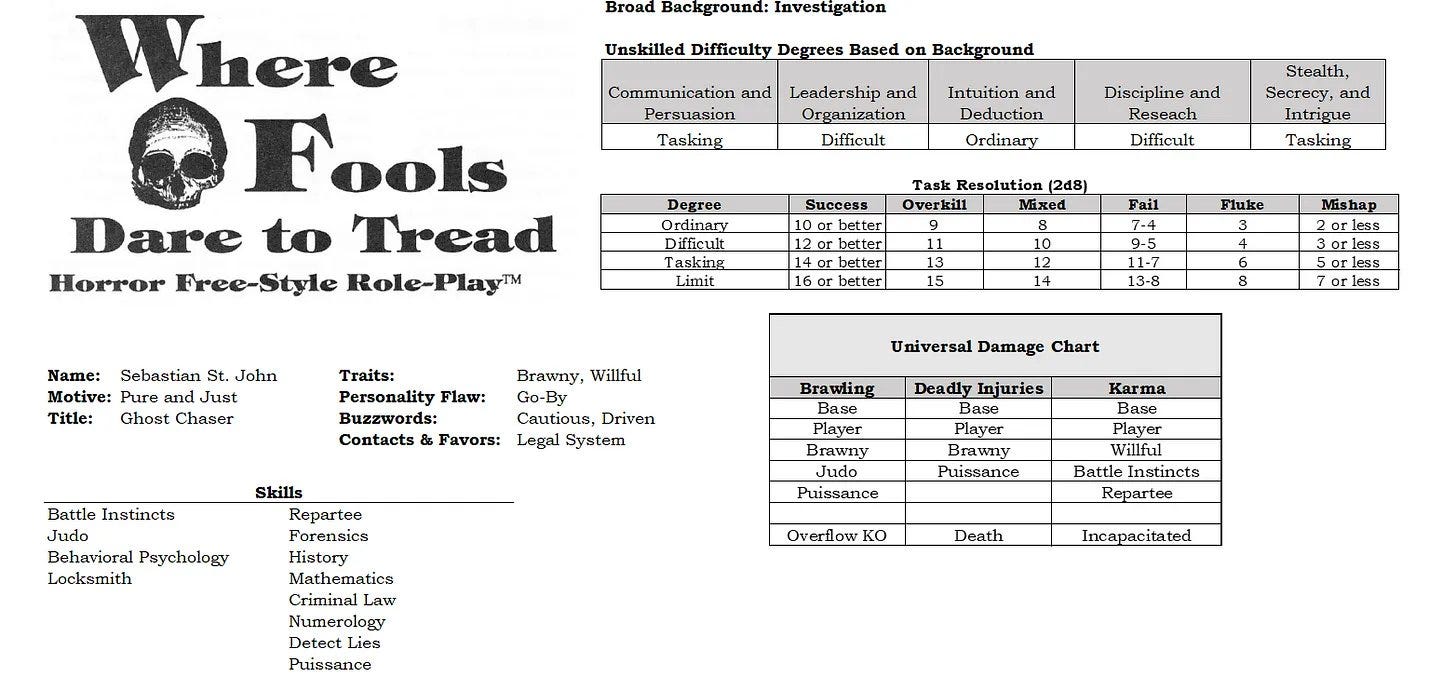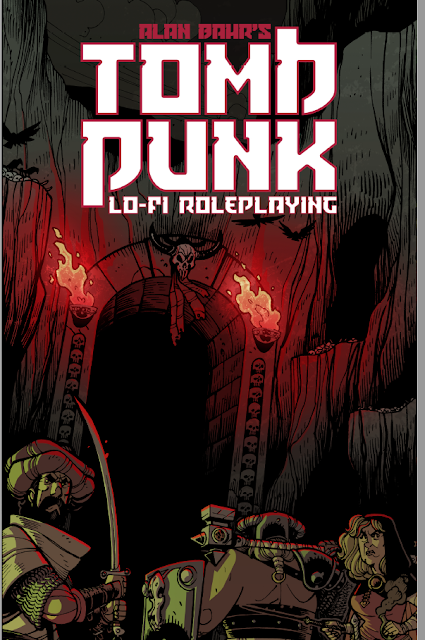I've been meaning to write this review for a couple of weeks now, but I've had the most terrible case of writer's block. I know what I think of the game, but being able to write out those thoughts in an organized manner has been a bit of a challenge. I'll attribute it to some recent life changes, none bad or unexpected, that are taking up more cognitive load than I was expecting. That and anxiety regarding finishing dissertation chapters, even as some of the data I need has yet to arrive, has led me to write less overall than I otherwise would. Time to get back on the old review horse though and share my thoughts on Alan Bahr's Tombpunk (affiliate link) from Outland Entertainment.
TL;DR
If you like the tension of Old School Gaming or are a big fan of Darkest Dungeon, then this game is for you.
Background
One of the things a lot of "old school" games try to recapture is the sense of urgency and risk of the early editions of Dungeons & Dragons and other table top role playing games of the era. It's a delicate balance between reward and risk that was best recreated in the video game Darkest Dungeon. It's a combination that can work for long term campaigns, if you are willing to have a certain level of detachment from your characters, but that is for many best suited to one shot adventures or short campaigns. That's the market niche that Alan Bahr targeted with his Tombpunk role playing game. The game was based on the system he used when running gaming sessions at role playing conventions and has four simple guiding principles:
Alan's system manages to meet all of the expectations created by each of these four principles, for better and for worse (though the worse isn't that bad) as we'll see as I go through my usual review format and cover "The Good, the Bad, and the Awesome."
The Good
In keeping with his overarching principles, Tombpunk has an easy to understand and quick to play game system that emulates its chosen genre extremely well. The system has at its core a simple attribute test resolution system that is divided into two subsystems. In the first subsystem players and GMs roll d12s against player character attributes. Players have to roll equal to or less than the number to succeed, while Monsters/NPCs have to roll greater than that number.
Wait a minute...did I just write "roll d12s?" Yes I did. Bahr uses the most underused of all the Platonic Solid rpg dice as the base die for resolution determination in this game. I love it.
Key here is that the difficulty number is always determined by the player character's attributes and not the attributes of the Monsters/NPCs. The only statistics Monsters/NPCs have in this game are Lifeblood (aka hit points), Attack Capability (do they roll the d12 to hit with Advantage, Disadvantage, or a Normal roll), and Damage. This keeps monster creation simple and allows for the game to be run with a very free-wheeling style.
Just as Monsters/NPCs are simple to design and run, so too are player characters. Players have three main attributes that are used in the first subsystem. These are Might, Grit, and Deftness and they cover a sufficiently broad spectrum of character abilities. The value of these statistics is determined by rolling a d4 and adding 4 to that number. Thus, characters have starting values in their attributes ranging from 5 to 8. This gives starting characters a 41% (for a 5) to 66% (for an 8) base chance of success for tasks for a given attribute. Conversely it gives Monsters/NPCs a 33% (for an 8) to 58% (for a 5) base chance for success. Advantage and Disadvantage (rolling 2d12 and keeping the highest or lowest) modify these probabilities.
Unlike a lot of modern role playing games, these attributes do not change as the character gains more experience. Instead of stat growth, Tombpunk focuses on the equipment and base class (Warriors, Shepherds, and Ritualists) abilities of the character for character growth. The base class abilities are relatively static and include the amount of damage all attacks from that character do, everything from weapon to spell damage is determined by the base attack damage of the class. This means that the majority of "power creep" comes from equipment choice. This is a nice mechanic because equipment is one of the areas where the GM can have the most influence in a game without appearing to be limiting player agency. Weapons and equipment have traits that can influence an action. For example a weapon might have "Armor Piercing" that allows it to ignore the damage
reduction of armor, or thieves' tools might give advantage in Deftness
rolls in certain situations (not a mechanic spelled out in the rulebook,
but one fitting with the philosophy on page 37.)
The second subsystem is where the "punk" in Tombpunk comes to light.
What's So Punk About Tombpunk?
For some time now in the post Cyberpunk era there has been a tendency to define new fiction and game genres as some sort of "punk." We've got Steampunk (a term coined to describe K.W. Jeter's
Morlock Night), Dieselpunk (as exemplified by
Mutant Chronicles), Atompunk, Rococopunk, Solarpunk, Elfpunk, and Younameitpunk. Unlike with Cyberpunk, I find that the addition of the word "punk" to these genres often suggests grim or hip instead of anything political and I'm left asking the question "what's so punk about x?" After all, punk is more than hairstyles and safety pins.
I didn't have to ask myself that question when reading Tombpunk. Sure, Tombpunk has the hairstyles and safety pins, but it also has a hostile economic system keeping the player characters down. That's right, Tombpunk has a short section on the unjust economic system, one that could inspire an entire campaign and one that is connected to the second subsystem of the game.


Bahr's simple section on the economics of Tombpunk sets a bleak tone for the world and gives a political motivation to adventuring and potentially using it to fund an eventual revolution. That's pretty punk. You probably noticed that the mechanics of the economics system are a "resource management" mechanic where the players need to earn enough of a resource in order to survive. The second subsystem of Tombpunk is a resource management subsystem and Coin isn't the only resource that characters need to manage. In addition to Coin, characters have Lifeblood (the HP resource from most rpgs), Courage, and Will. These last two resources are extremely valuable as they are needed to resist terror and to fight the effects of dark magics, but they are very hard to replenish or increase. This gives the game a sense of urgency over the long term that emphasizes the hopelessness and unfairness of the world, hopelessness and unfairness crying out for resistance.
The Bad
As much as I like the basic mechanics and tone of Tombpunk, especially for use as a one shot or limited campaign, there are two things that could be tweaked to make better long term game play.
The first is the strict ticking clock of the Courage and Will resources. Outside of the Shepherd's (read Cleric) ability to pray in order to restore 1 Courage or 1 Will to an ally, an ability that might cause the Shepherd to lose their own Will, there is no explicit way to get these resources back or to increase them. I understand Bahr's choice to limit increasing these resources, one of his guiding principles is to prevent power creep, but long term play might require a little more ability to replenish these resources. Given the tone of encroaching darkness Bahr is going for with Tombpunk, it might be better to allow replenishment only once a week or only after spending a week in town without adventuring. This creates a delicate balance between managing Coin, Courage, and Will. Keeping the last two at reasonable levels might lead to the characters running out of coin. This would add to the "wheel of economic alienation" underlining the baseline setting.
My second minor quibble is with the magic system. Bahr is a big fan of freeform magic systems, and I am too, but his games often lack a lot of guidance on how to implement a freeform system. In Tombpunk, Bahr provides only one specific example involving the use of Advantage/Disadvantage.

Essentially a Ritualist (read Magic User) can do any effect they desire with a successful Grit check, so long as the mechanical effects of the spell are equivalent to the 1d6 base damage that Ritualists have in their attacks. A 1d6 gout of flame? Fine, make a Grit check. One that does 2d6? Grit check with Disadvantage. That all seems fair, but doesn't provide much guidance for illusions, spider-climbing, flight, etc. The "cost" of such spells are a conversation between the DM and player. This is a lot like Tiny Dungeon or Mage the Ascension/Ars Magica, but the former game has a lot of fan support to fill the magic spells gap and the latter games contain chapters on how to adjudicate these kinds of effects. This isn't a "game killer," especially for experienced GMs and players, but it is a drawback for newer GMs and players. It's a drawback that opens the door to expansion though and given Bahr's love for including and encouraging "Micro-Settings" it's a drawback with a purpose. It leaves the door open to what level of magic a setting designer/GM wants in their games.
The Awesome
Finally, we come to what's awesome about the game. First and foremost is the art of Nicolás R. Giacondino. I don't know how Bahr found Nic, but their game designer/artist partnership is fantastic and has resulted in some of my favorite rpg illustrations. Nic has captured the "old school" evocative sensibility of artists like Jeff Dee and Bill Willingham, that balances the serious with the cartoony in a way that inspires the creative mind. I'm a big fan and would buy the books just for Nic's art.
 |
| Art by Nicolás R. Giacondino |
It's not just the art that's awesome though. As always, Bahr provides a plethora of optional rules and Micro-Settings to play around in. I cannot overstate how much I enjoy Bahr's use of Micro-Settings in his games. These are short kernels of long term campaigns that give you the basic concepts, the major villains, the overall "story," and key locations of a setting. You only get a couple here, but they have more than enough information to get you going and provide reading and viewing lists to further inspire your game play.
Bahr's designer notes at the end of the game remind us that all of the
"rules" are merely guidelines and that we are free to tweak as we want
and the interplay between designers, GMs, and players is the true spirit
of gaming.
Go out and buy Tombpunk on RPGNow (affiliate link).
 |
| Art by Nicolás R. Giacondino |




